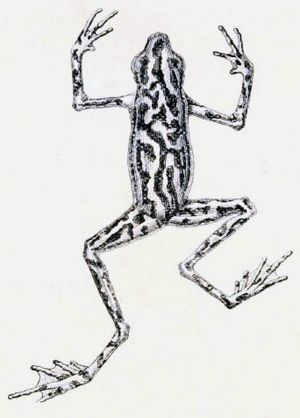Elegant stubfoot toad facts for kids
The elegant stubfoot toad or Pacific jambato frog (Atelopus elegans) is a special type of toad. It belongs to the Bufonidae family, which includes many different kinds of toads. You can find this toad in the lowlands and on the slopes of the Andes mountains in northwest Ecuador. It lives at heights up to 1,140 meters (about 3,740 feet) above sea level. This toad also lives on Gorgona Island, which is off the southwest coast of Colombia. In Spanish, people call it rana jambato del Pacífico or just jambato del Pacífico.
Contents
Discovering the Elegant Stubfoot Toad
This toad was first described by a scientist named George Albert Boulenger in 1882. He studied a female toad that Edward Whymper had collected during his trip to Ecuador between 1879 and 1880.
Toads found on Gorgona Island were first thought to be a different species called Atelopus gracilis in 1905. But later, scientists decided they were the same as Atelopus elegans. Some people still think Atelopus gracilis might be a special kind of Atelopus elegans, like a subspecies. The toads from Gorgona Island are brown, which is different from the mainland toads. This color difference makes scientists wonder if they are truly the same.
What Does It Look Like?
Male elegant stubfoot toads are quite small, measuring about 2.1 to 2.3 centimeters (0.8 to 0.9 inches) from snout to vent. Females are a bit larger, about 3.1 to 3.5 centimeters (1.2 to 1.4 inches) long.
These toads have a thin body and a long head. Their front and back legs are slender, and they have webbing between their fingers and toes. They do not have a visible eardrum (called a tympanum). Their skin feels smooth. The color on their back can range from a dark olive green to a bright yellow. They always have clear black spots or blotches on their back and legs. Their belly is yellow. However, the toads living on Gorgona Island are usually brown.
Where It Lives and Why It Needs Help
The elegant stubfoot toad naturally lives in humid rainforests, both in lowlands and on mountain slopes. Recently, in Ecuador, these toads have been seen in areas of new forest growth or in wet fields and pastures near these forests.
This toad is very common on Gorgona Island. However, its numbers have dropped a lot in Ecuador. This decline might be due to a disease called chytridiomycosis, which affects amphibians. In Ecuador, only one known group of these toads remains in the Esmeraldas Province. To help save them, a group of these toads is now being cared for by humans. The toads are also in danger because their habitat (the place where they live) is being lost.
See also
 In Spanish: Atelopus elegans para niños
In Spanish: Atelopus elegans para niños


